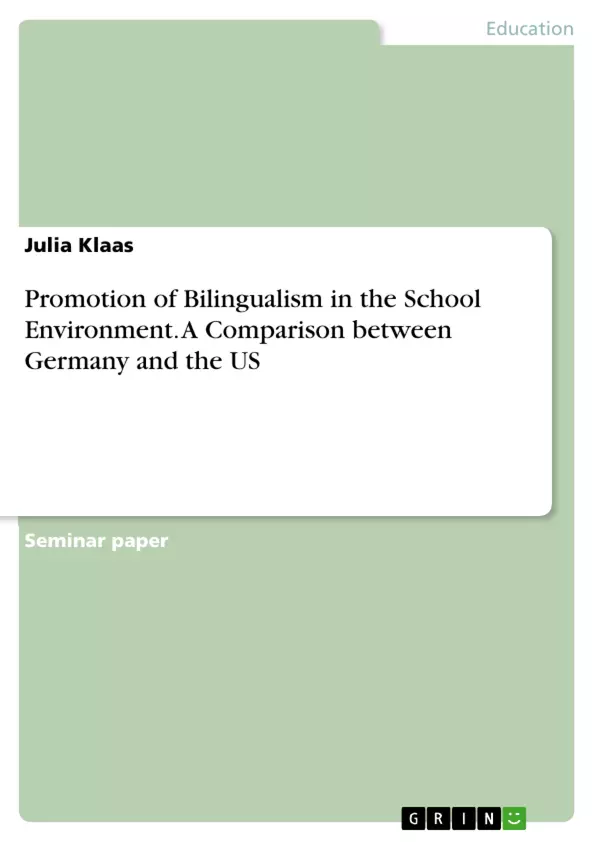In this paper, I will be focusing on the treatment of bilingualism in schools both as a ‘problem’ and a ‘benefit’, thereby analyzing the notions of “immigrant bilingualism” and “elite bilingualism”. It is interesting to me how bilinguals are perceived in German and American societies in general, something that I have already alluded to in this introduction, and how they are perceived in the school environment. I will also be looking at programs and schools that promote bilingualism in both countries and different languages, as well as the reception of bilingual students in ‘normal’ schools. Finally, I will explore some of the research done on the success of (mainly immigrant) bilinguals in the school environment: whether and in which situations or subjects their bilingualism helps or hinders students during their educational career.
"No one can say for sure how many people are multilingual, but a reasonable estimate is that at least half of the world’s population is in this category. Multilingualism is thus by no means a rare phenomenon, but a normal and common occurrence in most parts of the world."
This statement by Saville-Troike might some surprising to some, given that in many Western societies, the ability to use two (or more) languages is seen as something ‘special’ – however, I intentionally do not give away whether this characterization of ‘special’ is seen as something positive or negative. The fact is that in many of those same societies, whether being ‘special’ is good or bad depends on the languages that are spoken by that bi- or multilingual person.
Inhaltsverzeichnis (Table of Contents)
- I. Introduction on Bilingualism
- II. The Treatment of Bilingual Students in the German and American Educational Systems
- Bilingualism in Society
- Bilingualism in Schools: Promoted or Discouraged?
- Educational Success of Bilingual Children
- III. Conclusion
- IV. Works Cited
Zielsetzung und Themenschwerpunkte (Objectives and Key Themes)
This paper aims to analyze the treatment of bilingualism in the German and American educational systems. The paper explores how bilingualism is perceived in both societies, focusing on the distinction between "immigrant bilingualism" and "elite bilingualism." Additionally, it examines the impact of bilingualism on educational success, particularly in the context of learning the dominant language and additional foreign languages.
- The perception of bilingualism in American and German society
- The treatment of bilingualism in schools, including programs and schools that promote bilingualism and the reception of bilingual students in mainstream schools
- The impact of bilingualism on the educational success of students, specifically focusing on the influence of bilingualism on learning the dominant language (English in the U.S., German in Germany) and additional foreign languages
- The distinction between "immigrant bilingualism" and "elite bilingualism" in both countries
- The prevalence of bilingualism in the U.S. and Germany, particularly focusing on the Hispanic population in the U.S. and the diverse linguistic landscape in Germany
Zusammenfassung der Kapitel (Chapter Summaries)
The introduction provides an overview of bilingualism as a global phenomenon, highlighting the varying perceptions of bilingualism in Western societies. The author explores the social and educational context of bilingualism, particularly focusing on the experiences of bilingual children in the U.S. and Germany. This section sets the stage for the subsequent analysis of bilingualism in educational settings.
Chapter II delves deeper into the treatment of bilingual children in the German and American educational systems. The chapter explores the societal perception of bilingualism in both countries, highlighting the distinction between "immigrant bilingualism" and "elite bilingualism." This distinction is further explored in the context of educational programs and the reception of bilingual students in mainstream schools. The chapter concludes by examining the impact of bilingualism on the educational success of students, specifically focusing on the influence of bilingualism on learning the dominant language and additional foreign languages.
Schlüsselwörter (Keywords)
The key terms and concepts explored in this paper include bilingualism, multilingualism, immigrant bilingualism, elite bilingualism, educational success, dominant language, foreign language learning, language acquisition, and the perception of bilingualism in society.
- Quote paper
- Julia Klaas (Author), 2013, Promotion of Bilingualism in the School Environment. A Comparison between Germany and the US, Munich, GRIN Verlag, https://www.grin.com/document/492531



